The automotive landscape continues to evolve rapidly, with manufacturers striving to strike the perfect balance between performance, technology, and practicality. In this comparison, we look at two popular entries in the compact SUV segment: the Kia Sportage and the Mazda CX-30. Both vehicles have carved a niche for themselves with their unique offerings and innovations, making them strong contenders in the market. Let’s dive into the technical aspects and innovations that set these vehicles apart.
Kia Sportage vs Mazda CX-30 – Which one offers the better deal?
Compare performance, boot capacity, efficiency and price at a glance.
Find out which car is the better choice for you – Kia Sportage or Mazda CX-30?
Engine Options and Performance
The 2024 Kia Sportage comes with a diverse lineup of engine options catering to various driver needs. It offers a range of alternatives including Diesel MHEV, Petrol MHEV, Full Hybrid, Petrol, and Plugin Hybrid, giving it an edge in versatility. The power output ranges from 136 HP to a powerful 252 HP, with diesel options providing robust torque figures as high as 350 Nm. The Sportage showcases a quick acceleration from 0-100 km/h, clocking in as low as 8.3 seconds with its most potent engine.
On the other hand, the 2024 Mazda CX-30 is powered primarily by a Petrol MHEV which produces up to 186 HP. This positions the CX-30 as a capable vehicle, but with less engine variety compared to the Sportage. Its acceleration is commendable as well, reaching 100 km/h in as little as 8.3 seconds, but the maximum torque peaks at 240 Nm, which is lower than the Sportage’s highest output.
Fuel Efficiency
When it comes to fuel efficiency, the Kia Sportage stands out with consumption figures ranging between 5.0 to 7.2 L/100 km depending on the trim and engine choice. The availability of mild-hybrid and hybrid technologies contributes significantly to its impressive efficiency. Its Plugin Hybrid variant also boasts an electric range of up to 64 km, enhancing the appeal for environmentally conscious drivers.
The Mazda CX-30, while not as diverse in its engine offerings, is quite efficient in its own right. Fuel consumption figures vary from 5.7 to 6.6 L/100 km, making it a solid choice for daily driving. However, the absence of hybrid variants may deter buyers looking for an eco-friendly option.
Interior Space and Comfort
Space is a critical factor when evaluating SUVs, and both Kia and Mazda have imbued their models with functionality. The Kia Sportage boasts a generous trunk capacity ranging from 526 to 587 liters, which is excellent for families or those carrying larger items. The cabin of the Sportage is designed with comfort in mind, offering ample legroom and a high-quality interior that rivals more premium brands.
Conversely, the Mazda CX-30 offers a slightly smaller trunk capacity at 430 to 422 liters. However, it compensates with a driver-focused cockpit that emphasizes ergonomics and premium materials. The overall ambience of the CX-30’s interior is sophisticated, making it a pleasant place to spend time in.
Technology and Safety Innovations
In terms of technology, both vehicles are equipped with advanced features, but the Kia Sportage leans more into innovations. The Sportage includes a highly intuitive infotainment system, large touchscreen interfaces, and a series of driver-assistance technologies, such as adaptive cruise control and lane-keeping assist. Furthermore, the vehicle typically receives high ratings in safety tests, reflecting Kia’s commitment to driver and passenger security.
The Mazda CX-30, while offering a slightly less extensive tech package, does not fall short in safety features. Its innovative i-Activsense suite includes smart brake support and blind-spot monitoring, which contribute to its reputation for reliability. The CX-30’s infotainment system, albeit simpler, is functional and user-friendly, enhancing the overall driving experience.
Conclusion
Each vehicle has its strong points, making the decision largely dependent on personal priorities. The Kia Sportage shines with its extensive engine options, spacious interiors, and cutting-edge technology, making it ideal for families and tech-savvy drivers. Meanwhile, the Mazda CX-30 stands out with its stylish design, engaging driving dynamics, and premium interior, appealing to those who value aesthetics and comfort.
Ultimately, potential buyers should take both models for a test drive to experience firsthand how their distinctive characteristics align with individual preferences. In this competitive compact SUV segment, both the Kia Sportage and Mazda CX-30 offer compelling reasons to be considered for anyone’s next vehicle purchase.
Here’s where it gets real: The technical differences in detail
Costs and Efficiency:
Price and efficiency are key factors when choosing a car – and this is often where the real differences emerge.
Mazda CX-30 has a to a small extent advantage in terms of price – it starts at 25200 £, while the Kia Sportage costs 30200 £. That’s a price difference of around 4928 £.
Fuel consumption also shows a difference: Kia Sportage manages with 5 L and is therefore a bit more efficient than the Mazda CX-30 with 5.70 L. The difference is about 0.70 L per 100 km.
Engine and Performance:
Power, torque and acceleration say a lot about how a car feels on the road. This is where you see which model delivers more driving dynamics.
When it comes to engine power, the Kia Sportage has a clearly perceptible edge – offering 239 HP compared to 186 HP. That’s roughly 53 HP more horsepower.
In acceleration from 0 to 100 km/h, the Kia Sportage is slight quicker – completing the sprint in 7.90 s, while the Mazda CX-30 takes 8.30 s. That’s about 0.40 s faster.
In terms of top speed, the Mazda CX-30 performs barely noticeable better – reaching 204 km/h, while the Kia Sportage tops out at 203 km/h. The difference is around 1 km/h.
There’s also a difference in torque: Kia Sportage pulls distinct stronger with 320 Nm compared to 240 Nm. That’s about 80 Nm difference.
Space and Everyday Use:
Beyond pure performance, interior space and usability matter most in daily life. This is where you see which car is more practical and versatile.
Both vehicles offer seating for 5 people.
In curb weight, Mazda CX-30 is minimal lighter – 1455 kg compared to 1552 kg. The difference is around 97 kg.
In terms of boot space, the Kia Sportage offers clearly perceptible more room – 587 L compared to 430 L. That’s a difference of about 157 L.
In maximum load capacity, the Kia Sportage performs clearly perceptible better – up to 1776 L, which is about 370 L more than the Mazda CX-30.
When it comes to payload, Kia Sportage a bit takes the win – 580 kg compared to 496 kg. That’s a difference of about 84 kg.
Who wins the race?
The Kia Sportage proves to be dominates this comparison and therefore becomes our DriveDuel Champion!
Kia Sportage is the better all-rounder in this comparison.
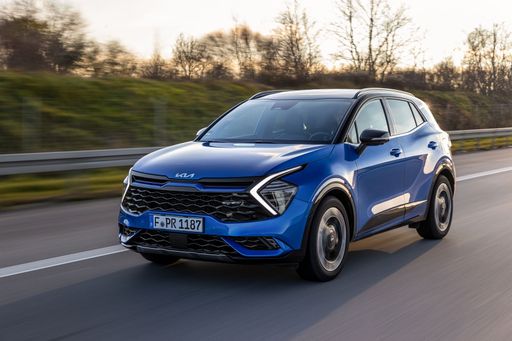 @ Kia Corporation
@ Kia Corporation
Kia Sportage
Kia Sportage
The Kia Sportage proves you don't have to choose between style and sensible family motoring, wrapping modern, confident looks around a roomy, well-equipped cabin. It's an easy car to live with — comfortable on daily runs, pleasantly engaging when you want a bit of fun, and kind to your wallet so you can keep smiling at the fuel pump.
details @ Kia Corporation
@ Kia Corporation
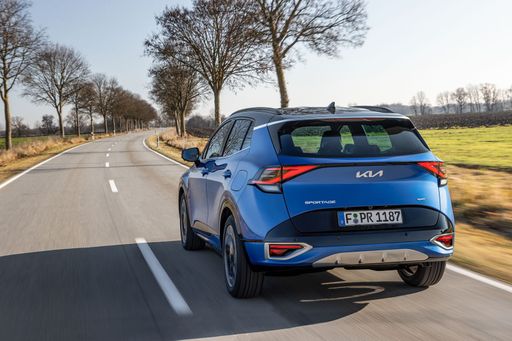 @ Kia Corporation
@ Kia Corporation
 @ Kia Corporation
@ Kia Corporation
 @ Kia Corporation
@ Kia Corporation
Mazda CX-30
The Mazda CX-30 blends sleek coupe-like lines with the practicality of a compact crossover, feeling more premium than its price tag suggests. It’s a joy to drive for anyone who likes a taut chassis and an interior that treats daily commutes like a small luxury escape.
details @ Mazda Motor Corporation
@ Mazda Motor Corporation
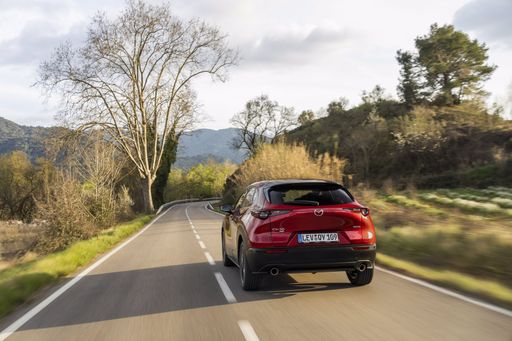 @ Mazda Motor Corporation
@ Mazda Motor Corporation
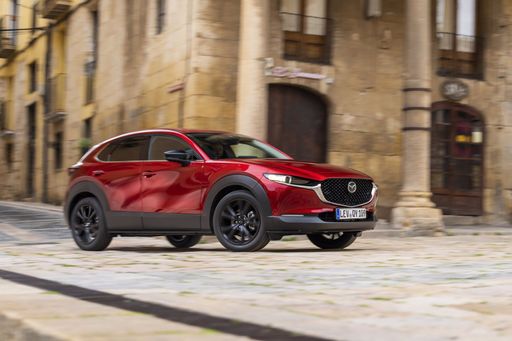 @ Mazda Motor Corporation
@ Mazda Motor Corporation
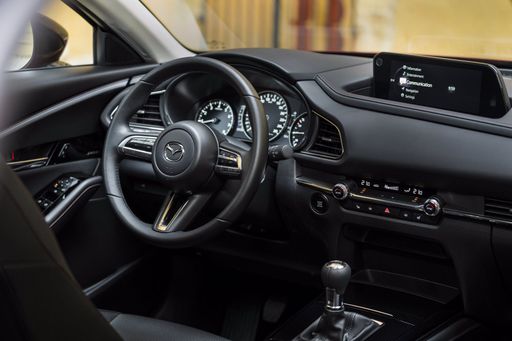 @ Mazda Motor Corporation
@ Mazda Motor Corporation
 @ Kia Corporation
@ Kia Corporation
|
 @ Mazda Motor Corporation
@ Mazda Motor Corporation
|
|
|
|
Costs and Consumption |
|
|---|---|
|
Price
30200 - 43900 £
|
Price
25200 - 36800 £
|
|
Consumption L/100km
5 - 7.9 L
|
Consumption L/100km
5.7 - 6.6 L
|
|
Consumption kWh/100km
-
|
Consumption kWh/100km
-
|
|
Electric Range
-
|
Electric Range
-
|
|
Battery Capacity
-
|
Battery Capacity
-
|
|
co2
132 - 180 g/km
|
co2
129 - 148 g/km
|
|
Fuel tank capacity
52 - 54 L
|
Fuel tank capacity
48 - 51 L
|
Dimensions and Body |
|
|---|---|
|
Body Type
SUV
|
Body Type
SUV
|
|
Seats
5
|
Seats
5
|
|
Doors
5
|
Doors
5
|
|
Curb weight
1552 - 1733 kg
|
Curb weight
1455 - 1587 kg
|
|
Trunk capacity
526 - 587 L
|
Trunk capacity
422 - 430 L
|
|
Length
4540 mm
|
Length
4395 mm
|
|
Width
1865 mm
|
Width
1795 mm
|
|
Height
1645 mm
|
Height
1540 mm
|
|
Max trunk capacity
1715 - 1776 L
|
Max trunk capacity
1398 - 1406 L
|
|
Payload
543 - 580 kg
|
Payload
458 - 496 kg
|
Engine and Performance |
|
|---|---|
|
Engine Type
Petrol, Full Hybrid, Diesel MHEV
|
Engine Type
Petrol MHEV
|
|
Transmission
Manuel, Automatic
|
Transmission
Manuel, Automatic
|
|
Transmission Detail
Manual Gearbox, Dual-Clutch Automatic, Automatic Gearbox
|
Transmission Detail
Manual Gearbox, Automatic Gearbox
|
|
Drive Type
Front-Wheel Drive, All-Wheel Drive
|
Drive Type
Front-Wheel Drive, All-Wheel Drive
|
|
Power HP
136 - 239 HP
|
Power HP
140 - 186 HP
|
|
Acceleration 0-100km/h
7.9 - 11.6 s
|
Acceleration 0-100km/h
8.3 - 10.3 s
|
|
Max Speed
180 - 203 km/h
|
Max Speed
191 - 204 km/h
|
|
Torque
250 - 320 Nm
|
Torque
238 - 240 Nm
|
|
Number of Cylinders
4
|
Number of Cylinders
4
|
|
Power kW
100 - 176 kW
|
Power kW
103 - 137 kW
|
|
Engine capacity
1598 cm3
|
Engine capacity
1998 - 2488 cm3
|
General |
|
|---|---|
|
Model Year
2025
|
Model Year
2025
|
|
CO2 Efficiency Class
F, D, E, G
|
CO2 Efficiency Class
D, E
|
|
Brand
Kia
|
Brand
Mazda
|
Is the Kia Sportage offered with different drivetrains?
The Kia Sportage is offered with Front-Wheel Drive or All-Wheel Drive.
The prices and data displayed are estimates based on German list prices and may vary by country. This information is not legally binding.
